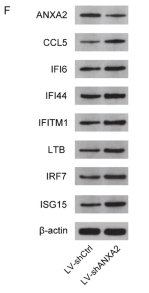| 产品: | ISG15 抗体 |
| 货号: | DF6316 |
| 描述: | Rabbit polyclonal antibody to ISG15 |
| 应用: | WB IHC |
| 反应: | Human, Mouse, Rat |
| 预测: | Pig, Zebrafish, Bovine, Horse, Dog |
| 分子量: | 18kDa; 18kD(Calculated). |
| 蛋白号: | P05161 |
| RRID: | AB_2838282 |
产品描述
*The optimal dilutions should be determined by the end user.
*Tips:
WB: 适用于变性蛋白样本的免疫印迹检测. IHC: 适用于组织样本的石蜡(IHC-p)或冰冻(IHC-f)切片样本的免疫组化/荧光检测. IF/ICC: 适用于细胞样本的荧光检测. ELISA(peptide): 适用于抗原肽的ELISA检测.
引用格式: Affinity Biosciences Cat# DF6316, RRID:AB_2838282.
展开/折叠
G1P2; hUCRP; IFI 15; IFI15; Interferon alpha inducible protein; Interferon induced protein 15; Interferon induced protein IFI-15K; Interferon stimulated protein 15 kDa; Interferon, alpha-inducible protein (clone IFI-15K); Interferon-induced 15 kDa protein; Interferon-induced 17 kDa protein; Interferon-induced 17-kDa/15-kDa protein; IP17; ISG 15; ISG15; ISG15 ubiquitin like modifier; ISG15_HUMAN; Ubiquitin cross-reactive protein; Ubiquitin-like protein ISG15; UCRP;
抗原和靶标
Detected in lymphoid cells, striated and smooth muscle, several epithelia and neurons. Expressed in neutrophils, monocytes and lymphocytes. Enhanced expression seen in pancreatic adenocarcinoma, endometrial cancer, and bladder cancer, as compared to non-cancerous tissue. In bladder cancer, the increase in expression exhibits a striking positive correlation with more advanced stages of the disease.
- P05161 ISG15_HUMAN:
- Protein BLAST With
- NCBI/
- ExPASy/
- Uniprot
MGWDLTVKMLAGNEFQVSLSSSMSVSELKAQITQKIGVHAFQQRLAVHPSGVALQDRVPLASQGLGPGSTVLLVVDKCDEPLSILVRNNKGRSSTYEVRLTQTVAHLKQQVSGLEGVQDDLFWLTFEGKPLEDQLPLGEYGLKPLSTVFMNLRLRGGGTEPGGRS
种属预测
score>80的预测可信度较高,可尝试用于WB检测。*预测模型主要基于免疫原序列比对,结果仅作参考,不作为质保凭据。
High(score>80) Medium(80>score>50) Low(score<50) No confidence
翻译修饰 - P05161 作为底物
| Site | PTM Type | Enzyme | Source |
|---|---|---|---|
| S26 | Phosphorylation | Uniprot | |
| K29 | Ubiquitination | Uniprot | |
| K35 | Ubiquitination | Uniprot | |
| S50 | Phosphorylation | Uniprot | |
| C78 | S-Nitrosylation | Uniprot |
研究背景
Ubiquitin-like protein which plays a key role in the innate immune response to viral infection either via its conjugation to a target protein (ISGylation) or via its action as a free or unconjugated protein. ISGylation involves a cascade of enzymatic reactions involving E1, E2, and E3 enzymes which catalyze the conjugation of ISG15 to a lysine residue in the target protein. Its target proteins include IFIT1, MX1/MxA, PPM1B, UBE2L6, UBA7, CHMP5, CHMP2A, CHMP4B and CHMP6. Can also isgylate: EIF2AK2/PKR which results in its activation, DDX58/RIG-I which inhibits its function in antiviral signaling response, EIF4E2 which enhances its cap structure-binding activity and translation-inhibition activity, UBE2N and UBE2E1 which negatively regulates their activity, IRF3 which inhibits its ubiquitination and degradation and FLNB which prevents its ability to interact with the upstream activators of the JNK cascade thereby inhibiting IFNA-induced JNK signaling. Exhibits antiviral activity towards both DNA and RNA viruses, including influenza A, HIV-1 and Ebola virus. Restricts HIV-1 and ebola virus via disruption of viral budding. Inhibits the ubiquitination of HIV-1 Gag and host TSG101 and disrupts their interaction, thereby preventing assembly and release of virions from infected cells. Inhibits Ebola virus budding mediated by the VP40 protein by disrupting ubiquitin ligase activity of NEDD4 and its ability to ubiquitinate VP40. ISGylates influenza A virus NS1 protein which causes a loss of function of the protein and the inhibition of virus replication. The secreted form of ISG15 can: induce natural killer cell proliferation, act as a chemotactic factor for neutrophils and act as a IFN-gamma-inducing cytokine playing an essential role in antimycobacterial immunity. The secreted form acts through the integrin ITGAL/ITGB2 receptor to initiate activation of SRC family tyrosine kinases including LYN, HCK and FGR which leads to secretion of IFNG and IL10; the interaction is mediated by ITGAL.
S-nitrosylation decreases its dimerization, thereby increasing the availability as well as the solubility of monomeric ISG15 for its conjugation to cellular proteins.
Induced as an inactive, precursor protein that is cleaved by specific proteases to expose the C-terminal diglycine (LRLRGG) motif. This motif is essential not only for its conjugation to substrates but also for its recognition by the relevant processing proteases.
Cytoplasm. Secreted.
Note: Exists in three distinct states: free within the cell, released into the extracellular space, or conjugated to target proteins.
Detected in lymphoid cells, striated and smooth muscle, several epithelia and neurons. Expressed in neutrophils, monocytes and lymphocytes. Enhanced expression seen in pancreatic adenocarcinoma, endometrial cancer, and bladder cancer, as compared to non-cancerous tissue. In bladder cancer, the increase in expression exhibits a striking positive correlation with more advanced stages of the disease.
Homodimer; disulfide-linked. Interacts with, and is conjugated to its targets by UBE1L (E1 enzyme) and UBE2E2 (E2 enzyme). Interacts with NEDD4.
(Microbial infection) Interacts with vaccinia virus protein E3.
(Microbial infection) Interaction with influenza B NS1 protein inhibits its conjugation.
Both the Ubiquitin-like 1 and Ubiquitin-like 2 domains are required for its efficient conjugation to cellular proteins. The two domains play different roles in the ISGylation pathway: Ubiquitin-like 2 domain is necessary for the first two steps allowing the linking of ISG15 to the E1 and E2 enzymes while Ubiquitin-like 1 domain is essential for the final, E3-mediated transfer of ISG15, from the E2 to the Lys of the target protein (PubMed:18356159).
研究领域
· Human Diseases > Infectious diseases: Viral > Human papillomavirus infection.
· Organismal Systems > Immune system > RIG-I-like receptor signaling pathway. (View pathway)
文献引用
Application: WB Species: Human Sample: HK2 cells
限制条款
产品的规格、报价、验证数据请以官网为准,官网链接:www.affbiotech.com | www.affbiotech.cn(简体中文)| www.affbiotech.jp(日本語)产品的数据信息为Affinity所有,未经授权不得收集Affinity官网数据或资料用于商业用途,对抄袭产品数据的行为我们将保留诉诸法律的权利。
产品相关数据会因产品批次、产品检测情况随时调整,如您已订购该产品,请以订购时随货说明书为准,否则请以官网内容为准,官网内容有改动时恕不另行通知。
Affinity保证所销售产品均经过严格质量检测。如您购买的商品在规定时间内出现问题需要售后时,请您在Affinity官方渠道提交售后申请。产品仅供科学研究使用。不用于诊断和治疗。
产品未经授权不得转售。
Affinity Biosciences将不会对在使用我们的产品时可能发生的专利侵权或其他侵权行为负责。Affinity Biosciences, Affinity Biosciences标志和所有其他商标所有权归Affinity Biosciences LTD.

